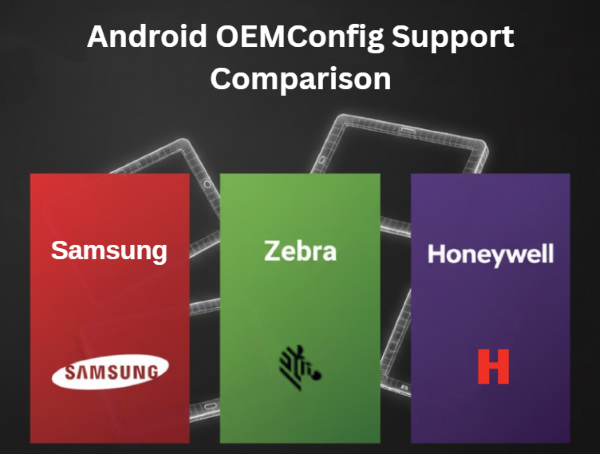Many IT managers will agree that the struggle when it comes to Android device rollouts is the differing OEMConfig support. These differences create headaches for many teams trying to maintain omni-security policies and restrictions.
It’s not as straightforward as it seems. Procurement using Android devices offers high-level flexibility (that we can agree on), but it comes with inconsistency in device management capabilities across different OEM for Android. The challenge is tied to the different levels of support OEMs provide for enterprise mobility management (EMM) features.
The framework of these EMMs lies beneath the OEMConfig. It’s designed to standardize all OEM-specific tools. However, support for OEMConfig varies widely between brands.
In this article, we compare the OEMConfig implementations of leading Android device manufacturers to help IT teams identify which vendors truly enable full control, security, and scalability.
I. Key Criteria for OEMConfig Comparison
When evaluating OEMConfig for Android enterprise deployments, we need to look beyond basic device enrollment. The real test comes down to how granular and comprehensive each manufacturer's management capabilities actually are.
Our comparison focuses on four critical areas that matter most to enterprise deployments.
Security Features
Security is the root of any enterprise deployment. We're looking at certificate management, VPN configuration, encryption controls, and biometric authentication policies. Some OEMs invest heavily here, offering hardware-level security enhancements, while others stick to basic Android security APIs.
Device Restrictions
Can you lock down cameras? Disable USB debugging? Control which apps can access location services? Device restrictions separate consumer-focused manufacturers from enterprise-ready ones. The depth of restriction policies often determines whether a device is suitable for regulated industries.
Enterprise App Management
App installation policies, sideloading controls, and application whitelisting capabilities vary dramatically between manufacturers. Some OEMs provide granular app management that goes well beyond Google's standard offerings.
Vendor Specifics & Ecosystem
Each manufacturer offers unique hardware features and software customizations, so the real question becomes: can you actually manage these proprietary features through MDM solutions? Samsung's S Pen controls, Zebra's barcode scanners, and Honeywell's ruggedized sensors all need proper OEMConfig integration to be useful in enterprise environments.
II. OEMConfig Comparison by Major Android OEMs
Let's examine how the major players handle OEM Android device management and OEMConfig support. The differences are more significant than you might expect.

1Samsung Knox (Most Advanced)
Extra deep security controls
Samsung doesn't just participate in Android Enterprise. They've built an entire parallel management ecosystem with Knox. Their OEMConfig implementation is arguably the most comprehensive in the Android space.
Knox provides security controls that go way beyond standard OEM Android applications in MDM. These include VPN kill switches, certificate-based authentication for Wi-Fi networks, and peripheral device management that can control everything from USB ports to SD card access. Samsung's approach treats the entire device as a manageable enterprise asset.
Zero-day policy updates via Knox Service Plugin
The standout feature? Zero-day policy updates through Knox Service Plugin. While other manufacturers wait for Android updates to roll out security patches, Samsung can push critical security policies immediately. This capability alone makes Knox attractive for security-conscious enterprises.
Widely supported across MDMs
Another advantage is MDM compatibility. Samsung works closely with major MDM vendors, ensuring Knox features integrate smoothly with existing management platforms. That way, you’re not locked into Samsung's own management tools.
2Zebra (Rugged Enterprise Devices)
OEMConfig is built on their Mobility Extensions (Mx) framework
Zebra takes a completely different approach to OEMConfig. Their implementation builds on the Mobility Extensions (Mx) framework, designed specifically for industrial and warehouse environments.
Deep control over ruggedized hardware features
The focus here is ruggedized hardware control. Zebra's OEMConfig lets you manage barcode scanning behavior, configure specialized keyboards, and control environmental sensors that don't exist on consumer devices. These are essential features for retail or logistics companies.
Advanced device provisioning and staging capabilities
Device provisioning capabilities stand out as particularly robust. Zebra devices can be staged and configured for specific roles before they ever reach end users. Warehouse workers can grab a pre-configured device that's already loaded with the right apps, network settings, and scanning profiles.
Essential for customizing device behavior in demanding environments
For demanding environments like warehouses and logistics operations, Zebra's OEMConfig integration provides controls that generic manufacturers simply can't match. The trade-off is complexity. Managing Zebra devices requires understanding their specialized hardware features and deployment scenarios.
3Honeywell
OEMConfig focuses on managing their "Mobility Edge" platform
Honeywell's OEMConfig centers around its "Mobility Edge" platform, which is designed for industrial computing scenarios. Like Zebra, it focuses on managing specialized hardware that doesn't exist in consumer devices.
Specialized controls for managing integrated peripherals
The strength lies in integrated peripheral management. Honeywell devices often include built-in scanners, imagers, and specialized sensors. Their OEMConfig implementation provides granular control over these components, including battery health monitoring and input/output configuration.
Honeywell excels in environments where devices need to interface with industrial equipment or specialized workflows. Their scanners and imagers can be fine-tuned through OEMConfig policies, ensuring optimal performance for specific use cases.
The challenge with Honeywell is the same as that of other specialized manufacturers. Their OEMConfig features are most valuable when you actually need their ruggedized hardware capabilities. For standard office deployments, the additional complexity may not justify the benefits.
III. Feature Comparison: OEMConfig Support by Vendors
| Feature | Samsung (Knox) | Zebra (Mobility Extensions) | Honeywell (UEMConnect) |
|---|---|---|---|
| Advanced Security | High | Medium | Medium |
| Peripheral Control | Medium (e.g., USB, Bluetooth) | High (Barcode Scanners, Physical Buttons) | High (Scanners, I/O) |
| Proprietary APIs | Yes (Knox Platform) | Yes (Mx) | Yes (UEMConnect) |
| OS Update Control | High (E-FOTA) | High (Staged) | High (Staged) |
| Device Staging | High (KME) | Very High (StageNow) | High (Enterprise Provisioner) |
| Primary Use Case | General Enterprise | Rugged/Logistics | Rugged/Field Service |
IV. Summary of Key Findings from the Comparison
The choice of OEM often comes down to matching hardware capabilities with your specific enterprise requirements. There's no universal winner, but there are clear leaders in different categories.
Samsung stands out for its comprehensive, enterprise-grade feature set that goes beyond the standard Android Enterprise framework. Knox provides security and management depth that's hard to match, making Samsung devices suitable for highly regulated industries and security-conscious organizations.
For industries requiring specialized hardware, Zebra and Honeywell excel by using OEMConfig to expose deep controls for their rugged devices. This capability addresses critical needs that generic consumer-focused OEMs simply can't meet.
The bottom line? Your OEM choice should align with your deployment requirements. Consumer-focused manufacturers work fine for office environments, but specialized industries need specialized OEMConfig capabilities.









Leave a Reply.